
Empididae is a family of flies with over 3,000 described species occurring worldwide in all the biogeographic realms but the majority are found in the Holarctic. They are mainly predatory flies like most of their relatives in the Empidoidea, and exhibit a wide range of forms but are generally small to medium-sized, non-metallic and rather bristly.
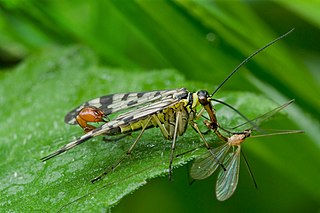
Panorpa communis, the common scorpionfly, is a species of scorpionfly.

Tachina fera is a species of fly in the genus Tachina of the family Tachinidae. It was first described by Carl Linnaeus in 1761.

Conops quadrifasciatus, the yellow-banded conops, is a species of fly from the genus Conops in the family Conopidae.

Empis livida is a species of fly in the family Empididae. It is included in the subgenus Kritempis of the genus Empis. Males range from 7.5 to 9.3 millimetres, females 7.5 to 10.2 millimetres. The male's abdomen is brownish, and his wings appear faintly brown and clouded. The female's abdomen is gray and her wings are clear. E. livida lives in hedgerows, feeding on the nectar of several species of Rosaceae, several species of Asteraceae, and Heracleum sphondylium nectar; they also feed on other insects. They live all across temperate and Northern Europe, the only species with such a wide distribution. E. livida larvae are also carnivorous and live in damp soil and leaf litter. Adults fly in between April and July.

Empis borealis is a species of dance flies in the fly family Empididae. It is found in most of Europe, except the Balkan Peninsula, the Baltic Region and the Iberian Peninsula. The brown wings of the female are very broad, while the male fly’s wings are narrower.
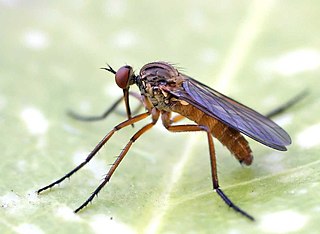
Empis stercorea is a large species of dance flies, in the fly family Empididae. It is included in the subgenus Xanthempis. It is found in most of Europe, except the Iberian Peninsula.

Empis pennipes is a species of dance flies, in the fly family Empididae. It is included in the subgenus Empis. It is found in most of Europe, except the Balkan Peninsula and the Iberian Peninsula.
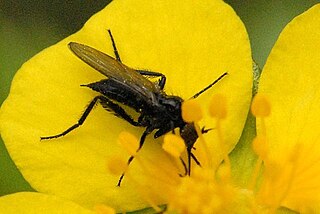
Empis planetica is a species of dance flies, in the fly family Empididae. It is included in the subgenus Empis. It is found in Ireland and Great Britain and from Scandinavia south to Italy.

Empis ciliata, the black dance fly, is a species of dance fly, in the fly family Empididae. It is included in the subgenus Euempis.

Empis digramma is a species of dance flies, in the fly family Empididae. It is included in the subgenus Xanthempis. The thorax is gray with yellowish sides, with two dark stripes following the line of the dorsocentral bristles. Abdomen is gray upper and yellowish on the sides. The fly's length is 5–7.5 millimetres (0.2–0.3 in).

Empis trigramma is a species of dance flies, in the fly family Empididae. The thorax with yellowish sides, with three broad dark stripes. Abdomen is shining yellowish, with a dark central stripe. The fly's length is 4.5–6 millimetres (0.2–0.2 in).

Empis syrovatkai is a species of dance flies, in the fly family Empididae. It is included in the subgenus Empis. It is found from Fennoscandia to northern Russia and in Denmark, the Benelux, Germany, Switzerland, Austria, the Czech Republic, Slovakia and Hungary.

Atherix ibis, the yellow-legged water-snipefly, is a species of ibis flies belonging to the family Athericidae, a small family very similar to Rhagionidae.
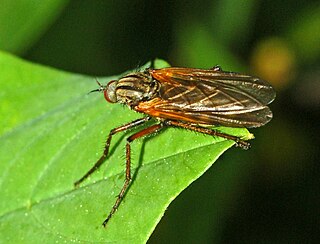
Empis (Xanthempis) testacea is a species of 'dance' flies belonging to the family Empididae subfamily Empidinae.

Chloromyia formosa is a species of soldier flies belonging to the family Stratiomyidae. Another name for it is Broad centurion.
Diptera is an order of winged insects commonly known as flies. Diptera, which are one of the most successful groups of organisms on Earth, are very diverse biologically. None are truly marine but they occupy virtually every terrestrial niche. Many have co-evolved in association with plants and animals. The Diptera are a very significant group in the decomposition and degeneration of plant and animal matter, are instrumental in the breakdown and release of nutrients back into the soil, and whose larvae supplement the diet of higher agrarian organisms. They are also an important component in food chains.

Neoitamus cyanurus, the common awl robberfly, is a species of 'robber fly' belonging to the family Asilidae.
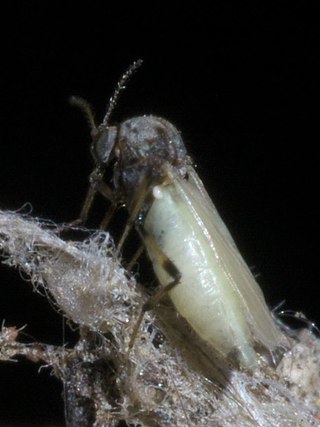
Bezzia nobilis is a species of biting midges in the family Ceratopogonidae. It is widely considered one of the most common Bezzia species; it is found in Eurasian regions, all over the United States, Central America, and even into South American countries like Brazil. B. nobilis seem to prefer aquatic environments; they are commonly observed in stagnant water pools in Eurasia regions and marshes in the southern United States. Adults of this species are easily distinguished by their black and yellow striped legs. Pupae are recognized by their brown bodies, abdominal spines, and respiratory horns. B. nobilis larvae are distinguished by brown heads and white bodies. Little information is known on their life cycle or mating habits. B. nobilis is a predatory species. While some research suggests they mainly feed on larvae of other insect species, experiments suggest they prefer immobile, easy prey such as dead adult flies, bacteria, and protozoa.
Empis snoddyi is a species of dance flies in the family Empididae. It is present in the United States, specifically mountainous areas from southern Virginia to northern Georgia. These flies are known for their distinctive mating ritual in which the males offer the females a large empty sack filled with hundreds of silk bubbles.




















